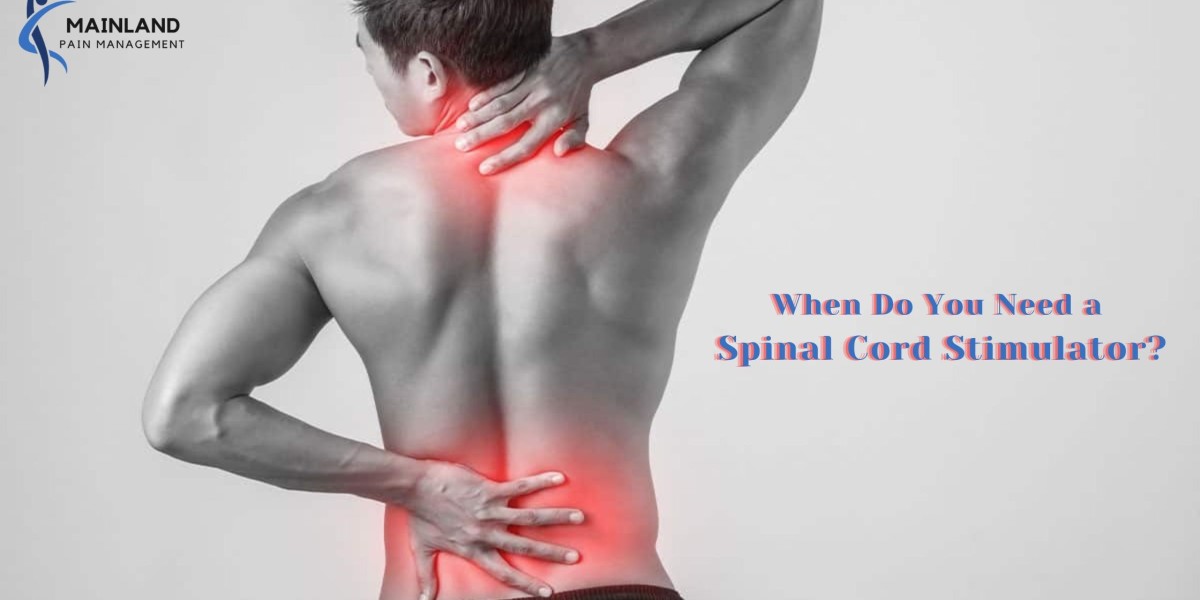When traditional pain management methods fail to provide adequate relief, alternative treatments may be considered. One such option is a spinal cord stimulator (SCS).
Dr. Dipty Mangla of Mainland Pain Management, who provides the best spinal cord stimulator in New Jersey, explains about how spinal cord stimulators work and the concept of a spinal cord stimulator. In this blog, let us discuss the conditions that may require Spinal Cord Stimulator use, and examine its potential benefits.
Understanding Spinal Cord Stimulator
A spinal cord stimulator is a device that delivers low-level electrical impulses to the spinal cord, specifically targeting the nerves responsible for transmitting pain signals to the brain. The device consists of a small generator implanted under the skin, usually in the abdomen or buttock area, along with thin wires carrying electrical impulses to the spinal cord.
Conditions that May Need a Spinal Cord Stimulator
Failed Back Surgery Syndrome: Failed Back Surgery Syndrome (FBSS) refers to the persistence or recurrence of chronic pain following spine surgery. In cases where traditional treatments and additional surgeries have not provided relief, a spinal cord stimulator is a viable option.
Complex Regional Pain Syndrome (CRPS): CRPS is a chronic pain condition typically affecting an arm, leg, hand, or foot, usually after an injury or trauma. Spinal cord stimulation can help alleviate the pain associated with CRPS and improve overall function and quality of life.
Neuropathic Pain: Neuropathic pain is caused by damage or dysfunction of the nerves, resulting in a chronic pain condition. Spinal cord stimulation has shown effectiveness in managing neuropathic pain caused by peripheral neuropathy, diabetic neuropathy, and nerve injuries.
Peripheral Vascular Disease: Peripheral Vascular Disease (PVD) refers to the narrowing or blockage of blood vessels in the extremities, resulting in pain and reduced circulation. Spinal cord stimulation can help alleviate the pain associated with PVD and improve mobility.
Arachnoiditis: Arachnoiditis is a rare condition characterized by inflammation of the arachnoid membrane, one of the protective layers surrounding the spinal cord. Spinal cord stimulation is a treatment option for managing chronic pain associated with arachnoiditis.
Potential Benefits of Spinal Cord Stimulator:
Pain Relief: The primary benefit of a spinal cord stimulator is pain relief. By delivering electrical impulses to the spinal cord, the device can help interrupt or block the pain signals from reaching the brain, reducing pain perception.
Reduced Medication Dependency: Spinal cord stimulation can reduce the need for pain medications, including opioids, which can have significant side effects and the risk of dependency.
Improved Function and Quality of Life: A spinal cord stimulator can help improve overall function and quality of life by managing chronic pain. With reduced pain, individuals may engage in activities they previously could not perform, enhancing their physical and emotional well-being.
Reversible and Adjustable: One advantage of a spinal cord stimulator is its reversible and adjustable nature. If the device does not provide the desired level of pain relief, it can be turned off or removed. Additionally, the stimulation parameters can be adjusted to better target the specific areas of pain.
Improved Sleep and Mental Health: Chronic pain can significantly impact sleep patterns and contribute to mental health issues such as anxiety and depression. By effectively managing pain, a spinal cord stimulator can help improve sleep quality and alleviate the emotional burden associated with chronic pain, leading to enhanced mental well-being.
Enhanced Physical Function: Chronic pain often limits physical function and mobility, making engaging in daily activities and exercise difficult. By reducing pain, a spinal cord stimulator can improve physical function, allowing individuals to participate in activities they enjoy and maintain a more active lifestyle.
Personalized Pain Management: Spinal cord stimulation offers the advantage of customization. The device can be programmed and adjusted to meet an individual's specific pain management needs. This personalized approach allows optimal pain control, as stimulation settings can be modified based on changes in pain patterns or individual preferences.
Non-Destructive Alternative: Unlike certain surgical interventions involving permanent alterations to the body or high-dose pain medications, spinal cord stimulation offers a non-destructive alternative. It provides pain relief without permanently altering the anatomy or relying solely on medications, making it appealing for individuals seeking conservative treatment options.
Conclusion:
A spinal cord stimulator is a potential treatment option for individuals suffering from chronic pain conditions that have not responded to other conventional methods. The device can help manage pain, reduce medication dependency, and improve overall function and quality of life by providing electrical impulses to the spinal cord. However, consulting with a pain management physician in New Jersey is essential to determine if a spinal cord stimulator is the appropriate choice for your specific condition. They can evaluate your individual needs, discuss the potential benefits and risks, and guide you through the process to make an informed decision about this intervention for chronic pain management.
If you are looking for the best spinal cord stimulator, Dr. Dipty Mangla, a leading pain management physician in New Jersey of Mainland Pain Management can be consulted.








